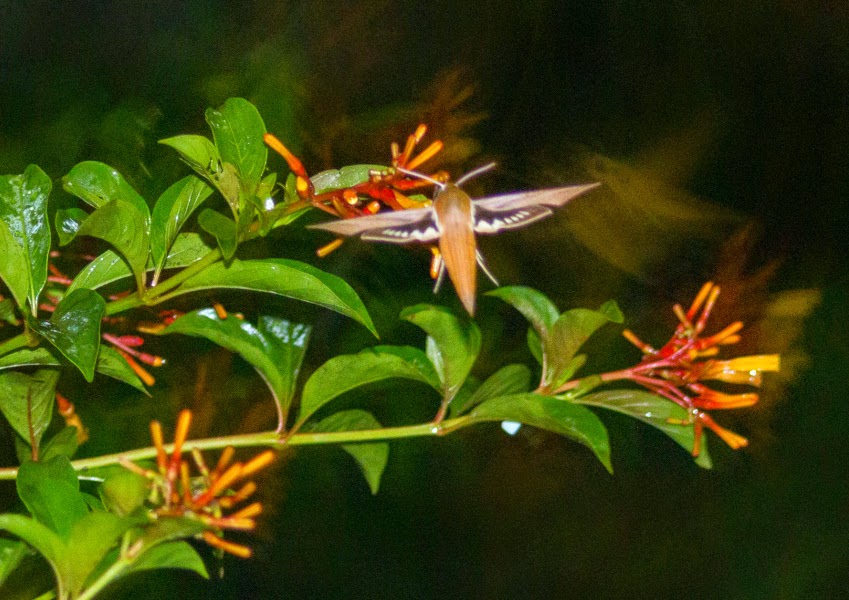My husband was leaving for work about 5:30 the other morning and I followed him out to the front porch. Something moved in the darkness and I turned to look. I squinched my eyes and tried to hone in on the moving object but couldn't get a clear view of it. I wished I had my eyeglasses on.
What is that? It moves like a baby Hummingbird. But, I knew it wasn't. I listened closely for the familiar "hum", but heard nothing. Whatever this was closely resembled a Hummingbird in flight- it moved swiftly across the Hummingbird bushes, up and down, back and forth with rapid wing beats.
I grabbed my camera, placed the setting on night vision and began shooting. When the flash exposed the object, I could see that it was clearly not a Hummingbird. A few more flashes of light allowed me to conclude that it was a large moth.
I randomly shot several photos of the moth and was able to get close in for a few of them. I remembered the photos of the Hummingbird Moth that another blogger had posted. I bet this is a Hummingbird Moth.
A search online confirmed my conclusion. This is a Tersa Sphinx. The Hummingbird Moth belongs to the family of moths technically called the Sphingidae family or Sphinx family of moths. A hummingbird moth can be considered to be a medium to large moth with a wingspan of five (5) or more inches. They tend to fly strong and fast like a hummingbird with rapid wing beats. The hummingbird moth is usually active at dusk. However, they have been known to be active throughout the day traveling from flower to flower, much like a hummingbird. The hummingbird moth will feed on a flower much like a hummingbird. But instead of a beak and tongue to lap the nectar, they have a proboscis which resembles a long, thin straw. If you look closely at the above photo, you can see the curled proboscis on this moth.
I wonder what else lurks in the darkness, among my flowering bushes and potted plants...I should investigate more often, there's no telling what I may see.
Thank you for dropping in...
Have a good week, what's left of it :)








they're such amazing creatures! i've only seen one or two here. very good spotting!
ReplyDeleteThank you, Theresa. I hope I'll spot more of them in the future.
DeleteYou really captured this beauty! Wonderful shots.
ReplyDeleteThanks Connie :)
DeleteOh Wow! A good find indeed! In flight they are difficult to capture, but these are excellent shots. I have seen the Macroglossum stellatarum Sphingidae) many times in my garden, but I have never seen this kind. It's a beauty!
ReplyDeleteThank you so much! I so enjoy your photos!
DeleteThere was a nice reward for getting up so early Susan. You managed to get some good pictures too.
ReplyDeleteI see Hummingbird Hawk Moths when I go to Spain in Springtime, but not up here in the North of England.
Thanks a million, Phil :)
DeleteIt sure is beautiful!!!
ReplyDeleteThank you, Kerri!
DeleteHow wonderful! You got some great photos! I had always wanted to see one, and noticed one the other day, very briefly, but didn't get any photos as he was on the move. Very neat moth.
ReplyDeleteI can't do traditional camping anymore either. You'll see by my next post that I can't do "little cabin KOA" camping either! :-)
Love all your travel photos, Marie. They're wonderful!
DeleteYes, aren't they super?...:)JP
ReplyDeleteIndeed they are, JP :)
Delete